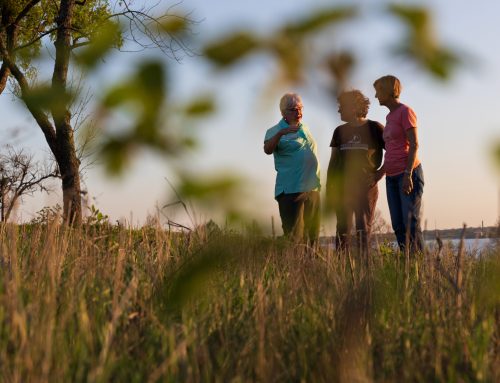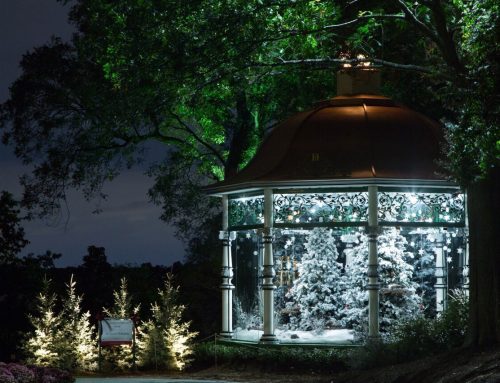With a dreamy, faraway gleam in her eyes, 62-year-old Ruby Frazier plops down on a sofa and begins talking lovingly about dirt, the smell of a warm summer breeze and her undying passion for gardening.
“At this point in your life, they say you need a passion,” Frazier says. “And this is what our passion is now. It gives a great deal of satisfaction to dig in the dirt and see the fruits of your labor.”
“We see it as part of our entertainment budget. I enjoy looking out the window at our flowers as much as I enjoy going to a movie.”
“You’re really tired at the end of a day, but it’s a good kind of tired as long as you end up with dirt underneath your fingernails.”
TIME BEGAN IN A GARDEN
Many of us may not be too excited about trading dinner or a movie for dirt under our fingernails.
In fact, in a world of electronic wizardry and instant gratification, the simple art of nurturing a plant to life seems, well, mundane. But something as simple as a single blossom can brighten an otherwise bleary day.
And a single neighbor’s passion for gardening can influence an entire neighborhood for the better, neighborhood gardeners say. Even the actual act of gardening can be therapeutic.
Perhaps neighborhood gardening writer Jeanette Crumpler says it best:
“Even the most jaded person in the world enjoys looking at a beautiful flower,” Crumpler says. “That joy is doubled when you grow it yourself.”
“You know the old saying: Time began in a garden.”
THE PASSION OF GARDENING
On this cool, threatening afternoon, Bill and Ruby Fraziers’ thoughts are elsewhere, thinking of warmer days spent in the moderate Texas springtime heat.
To Ruby and Bill, nothing is more satisfying than a Saturday in the yard, a day of fulfilling the passion they share – the passion of gardening.
Bill and Ruby have lived in the same house for 23 years. They’re the first to admit their now-splendid garden once played host to a matty jungle of front-yard vines.
“The kids used to love playing in them,” Ruby says. “One kid would slither out and then another and another, and before you knew it, 10 kids would have emerged.”
“Once the kids grew up, we began to clean up. Now, we have lots of people who stop their cars to look at our garden. One time, an artist stopped by unannounced and wanted to paint.”
Another time, a couple took one look at the garden and decided to get married there, Ruby says.
Bill, a retired school principal, says the Fraziers’ typical spring day begins by sitting on the bench in their garden, cup of coffee in hand, and selecting a project for the day ahead.
“The busiest time for us is the spring,” Bill says. “Weather permitting, we’re out there every day doing something.”
WINE, CHEESE AND A GARDEN HOE
An article about an eccentric group of San Francisco Bay Area residents known as the Hortisexuals caught the eye of Hollywood Heights resident Carrie Furman.
Enthralled by the idea of a diverse group of people sharing a common interest, Furman decided to form a similar organization in East Dallas.
Immediately, Furman found a handful of interested neighbors. The group convened, stated their purpose and tried to come up with a name.
“That (finding a name) was the hard part,” Furman says.
While they don’t possess the catchy moniker of their West Coast cousins, the East Dallas Horticultural Society offers members a similar blend of educational programming and social activity.
And like the Hortisexuals, the East Dallas Horticultural Society is a loosely bound yet unified structure, one that refuses to govern itself with haughty rules and regulations.
Michael Cheever, Director of the Dallas Horticultural Center and a Hollywood Heights resident, helped start the organization.
“I called a guy in Oakland to see how it (the Hortisexuals group) functioned,” Cheever says. “Unlike a lot of traditional gardening associations, it’s very informal, and dues are insignificant. We wanted to model that.”
And that’s just what they did.
Not yet a year old, the East Dallas Horticultural Society has a membership base that includes residents from throughout East Dallas.
“We are trying to get to where more people know each other,” Furman says. “We’ve got everyone from basic home gardeners to professionals.”
And it’s that membership diversity that makes the organization unique. Members interact in a relaxed setting, usually meeting at one another’s homes over a glass of wine and a few laughs.
Membership will set you back $15 a year, a fee that pays for newsletter publication and postage. (Call 214-327-9081 for membership information.)
In addition to a full schedule of weeknight lectures, and tours of gardens and nurseries, the group also is planning out-of-town trips to botanical gardens.
“To get the opportunity to see other people’s gardens and have the owner there to tell you what worked and what didn’t is excellent hands-on information,” Cheever says. “We try to have something for everyone. Out of four meetings, we’ve had a different mix each time.”
Furman says that East Dallas is the perfect environment for not only gardening, but for a gardening club.
“This area is so diverse and there are so many people getting into gardening,” Furman says. “We got going and have been getting a great response ever since.”
A CHAMPION OF THE ENVIRONMENT
Mike Thompson has dreamed about it for as long as he can remember. Now, it’s a reality.
A little over eight months ago, Thompson and Chris Brumley, both residents of East Dallas, opened Sticks and Stones, a garden market specializing in organics, perennials and natives, antique roses, garden collectibles and gifts.
Located at 5016 Miller, on the fringe of Vickery Place, Sticks and Stones caters to an increasingly popular lifestyle centered around environmentally sound gardening practices that coincide with home and yard beautification.
“I see it (Sticks and Stones) as a tool,” Thompson says. “We want to create an atmosphere that demonstrates an eclectic taste in home and yard.”
In addition to the various plants, products and accessories available at Sticks and Stones, Thompson and Brumley also offer a number of in-store classes and seminars for everyone from beginning to experienced gardeners.
“We want to encourage our customers to be more conscious, more organically minded,” Thompson says.
Thompson has taken that message into the community, speaking to homeowners’ associations, gardening clubs and school children.
“Being that this is an older neighborhood, we went through the chemical dousing of the 1950s and 1960s,” Thompson says.
“Unfortunately, that was the way people gardened. That is the basis of doing our free organic gardening classes and going out into the community.”
Last year, Thompson visited White Rock Montessori School and helped the school’s students put together an experimental garden designed to attract butterflies.
Thompson is adamant about the benefits of organic gardening and views the products and programs he provides as an agent of change for the community, a change he says will lead to a healthier environment.
“It (gardening) is everything to me,” Thompson says. “For some who are true gardeners, it’s a sustenance – it’s like a food.”
COMPOSTS AND COMPOSITIONS
Jeanette Crumpler has been gardening since she was three years old.
“They tell me I used to tag along behind my grandparents, always wanting to know which plants were which,” Crumpler says.
At 63, she says old knees and an assortment of other aches and pains have forced her to cut back on the time she spends toiling in her LaVista garden. Over the past eight years, Crumpler has traded much of the time she once spent working in her backyard for long hours of putting pen to paper.
Crumpler says she first decided she might be able to make a go of it as a gardening writer some years ago while doing seed testing for the National Gardening Association.
As a seed tester, Crumpler found herself frequently corresponding with the NGA, reporting her findings and observations regarding the various seeds she tested.
“They thought the way I wrote would be beneficial for gardening magazines,” Crumpler says. “I usually try to write six to eight gardening articles a year depending on who will buy them.”
“A lot of young people want to garden and usually want to do it organically. They just need a little encouragement and wisdom in order to do it.”
Crumpler also enjoys writing humorous tales about the trials and tribulations of gardening. At the heart of her writing, however, is the emphasis she places on the nostalgia of gardening.
“Gardening teaches patience, appreciation and endurance,” Crumpler says. “It can bring a lot of real joy.”





